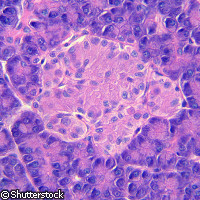Scientists uncover missing piece in diabetes puzzle
More than 170 million diabetics worldwide may soon breathe a sigh of relief thanks to an international team of scientists that has uncovered the culprit that triggers this debilitating disease. Presented in the journal Nature, the study's findings show that the previously unstudied gene known as RFX6 is responsible for congenital diabetes. Diabetes arises when the pancreas fails to produce sufficient amounts of insulin because the islets of Langerhans (special groups of cells found in the pancreas) are damaged and cannot make and secrete hormones that help the body break down and use food. There are five types of cells in an islet, of which beta cells are responsible for producing insulin. The scientists from Belgium, Canada and the US tackled this problem by identifying a deficiency in the beta cells of the pancreatic islets of Langerhans that causes diabetes. The researchers from Université Libre de Bruxelles (ULB) in Belgium cooperated with colleagues from McGill University in Canada to determine the cause of diabetes in humans. Their US counterparts at the University of California San Francisco (UCSF) identified the biological role of the RFX6 gene in mice. In a statement, the Belgian researchers said genomic medicine targets prevention and treatment that is tailor-made to individuals. While experts in the medical field have effectively applied this approach to treat breast and intestinal, cancers, for example, its use is still limited for other diseases due to the lack of understanding of the underlying molecular mechanisms. Experts note that understanding is fuelled by the observation of rare diseases triggered by the absence of a particular gene in the genome. 'We believe that for each of the 30,000 genes in our genome, there is a least 1 person on this Earth that has an inherited defect,' the ULB scientists say. The Medical Genetics Service at Hôpital Erasme-ULB has developed clinical skills that facilitate the diagnosis of diseases, even for extremely rare cases that have never before been observed. Dr Julie Désir of the Medical Genetics Service, along with Dr Serge Vanden Eijnden of the Department of Neonatology at Hôpital Erasme-ULB, observed in a seriously ill newborn baby a set of congenital abnormalities, primarily diabetes and certain defects in the digestive system, that characterise Martinez-Frias syndrome. The baby's parents are blood-related, healthy first cousins. However, the researchers noted a history of diabetes in the immediate family, including the parents and their siblings, aunts and uncles. 'One could postulate that the gene responsible, yet unknown, played a major role in the development of islets of Langerhans and the production of insulin, causing the full Martinez-Frias syndrome in the infant,' they say. The Canadian researchers, led by Dr Constantin Polychronakos of McGill's Endocrine Genetics Laboratory at the Children's Hospital site of Research Institute of the McGill University Hospital Centre (RI MUCH), used advanced technologies including highly parallel sequencing to investigate the RFX6 gene. 'This discovery brings us closer to one day finding a cure for diabetes,' Dr Polychronakos explained. 'Now that we know the RFX6 gene is crucial in the process of insulin production, the door is open to finding a cure through gene therapy or therapeutics that will create new islets out of cells from the rest of the pancreas.' Scientists that also contributed to this study were from France, Italy and the UK.
Countries
Belgium, Canada, France, Italy, United Kingdom, United States



